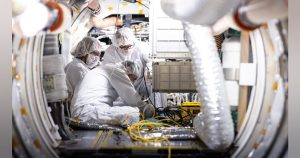Research Initiative Seeks Fusion of Biology and Microsystems for Self-Repairing Creatures
Date: February 3, 2025
The MICA program aims to explore the interplay between microsystems and molecular control. U.S. military researchers are soliciting contributions from the industry to innovate in managing biological operations through microsystems and molecular catalysts. This initiative is spearheaded by the Defense Advanced Research Projects Agency (DARPA) based in Arlington, Virginia, which has released a solicitation (HR001125S0007) for the Microsystem Induced Catalysis (MICA) project.
Potential Applications of Artificial Cells
Military scientists are optimistic about the potential of this research to pave the way for the creation of artificial cells that emulate living cells, enabling functionality in sensing, information processing, and self-repair capabilities.
DARPA first unveiled its intention to kickstart the MICA program in December and provided an industry briefing about the project in late January.
Objectives and Goals of the MICA Program
The primary aim of MICA is to develop technologies that incorporate electronic, mechanical, and biological components, facilitating machines that can perceive, learn, evolve, and mend themselves. Interestingly, the electronic processes in transistors bear similarities to molecular interactions in living organisms, suggesting that a synthesis between biological modules and electronic devices could be effectively achieved.
Microsystem Applications in Biological Controls
The spotlight of the MICA program is on the manipulation of biological functions through microsystem technologies. It will emphasize the demonstration of hardware integrating molecular catalysts with microsystem frameworks, governed by physical forces produced by these microsystems.
This program also embraces modeling and simulation tasks for integrated molecular microsystems, concentrating on biomolecular catalysts.
Integration Strategies for Catalytic Molecules
A significant focus of MICA lies in the integration of catalytic molecules with microsystems to facilitate biological processes. The project aims to ensure compatibility with standard microelectronic manufacturing processes.
Strategies involved will include predicting molecular structures and accompanying functionalities, linking them with field-programmable gate arrays (FPGAs) and CMOS logic circuits.
Invitation for Collaboration
The MICA initiative will establish two categories of professional teams: one focusing on the molecular design paired with microsystem fabrication aimed at controlling molecular functions, and another that specializes in simulating system performance to create apparatuses for predicting integrated outcomes.
Organizations interested in participating should submit abstracts by February 5, 2025, and full proposals by March 20, 2025. Further details can be found on the DARPA BAA website [visit here].
If you have any questions or require more information, please reach out to the DARPA BAA coordinator at [email].
For more details, visit [this link].

About the Author: John Keller serves as the Editor-in-Chief of Military & Aerospace Electronics Magazine, providing comprehensive coverage and insights into enabling technologies in military, aerospace, and commercial aviation sectors.













